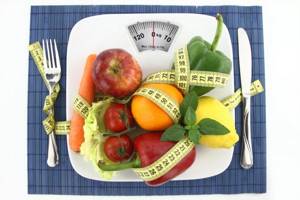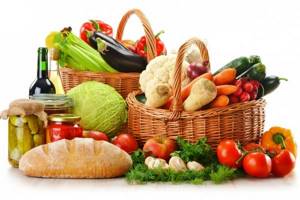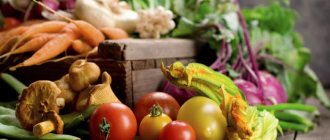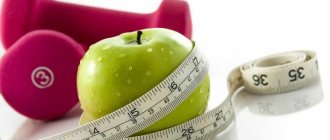The essence of a low-calorie diet
The specificity of a low-calorie diet is obvious, it follows from the name - it assumes a low bar for the total number of calories consumed. People who want to lose weight need this regimen.
The term “low-calorie” is used in two meanings: narrowly, denoting a specific diet with its three types, and broadly, meaning any nutritional system based on reducing food intake, which leads to a decrease in calorie content.
Low-calorie nutrition has two directions:
- reduce the total calorie content of foods;
- consume foods low in calories.
They, as a rule, are combined with each other, but the main principle remains unchanged: nutrition should be limited.
There are tables from which you can find out how many kilocalories a person should consume per day, depending on his gender, height, age, and occupation. The numbers vary, but there is a certain basic daily nutritional value, that is, the number of kilocalories that the body needs so that it can maintain its needs. For the average woman this level is 1200 kcal/day, for the average man it’s a little more – 1400 kcal/day.
The approach is simple: if a person consumes a larger volume of calories without having high energy costs (hard physical work, sports training), then the food will be processed into fat and stored in reserve, that is, the person will gain weight; if he consumes less, then exhaustion will occur.
conclusions
A low-calorie diet helps to get rid of a few extra pounds before any important event, but it is worth considering that the achieved result will be short-lived if you leave your lifestyle unchanged. This technique can clearly demonstrate the need for change, so it is worth considering it as the first step towards healthy eating, not only for achieving a slim figure, but also for good health and well-being.
Reader’s story “How I lost 18 kg in 2.5 months” I’ve been fat all my life and suffered from excess weight. In clothing stores I chose size L, which by the age of 25 turned into XL and continued to grow. I can tell you for a long time how I tried to fight my 30-35 extra pounds: diets, hunger strike, physical activity, even pills and some kind of conspiracies. The effect was short-lived or absent altogether. In short, despair, depression and almost resignation to one’s enormous weight. But one day I came across... a chocolate bar that helps you lose weight! It didn’t cost me anything to try it - I love chocolates. I ordered it and ate it. And the weight crept down!! It seems like mysticism, but it's true. I began to study the issue and realized how it all works. Girls, try it! I have already lost 18 kg in 2.5 months. And I continue. It's up to you, but you don't lose anything except weight, of course. Try Choco Burn chocolate for weight loss for 147 rubles.
Calorie base and its factors
A low-calorie diet is a diet in which the body is placed in conditions where it is forced to burn more energy than it consumes.
Each person has their own calorie base, when reduced, the process of weight loss begins, and it is better if a professional nutritionist helps you calculate it.
Here are the factors to consider:
- age (the body’s metabolism depends on it; the older the person, the slower the metabolism);
- gender (in men, compared to women, energy consumption is 200-300 kilocalories more, mainly due to muscle mass);
- lifestyle (sedentary or energy-intensive);
- previous diet (how correct or incorrect the person followed);
- chronic diseases (are there any contraindications);
- psychological state (ability to withstand a dietary test without breakdowns).
A person who decides to master a low-calorie diet must be prepared for culinary accounting. You will need to acquire tables of caloric content of dishes, since they are the basis for constructing a menu. You will have to scrupulously count calories, add them up, and write them down so as not to forget or get lost. Now, in an era where everyone has a mobile phone with a built-in calculator at their fingertips, this process has become much easier.
Gender differences should be taken into account, since they are of no small importance, expressed as follows:
| Factor | Men | Women |
| Number of meals/day | At least 5 | 6 |
| Daily calorie content | Up to 1400 kcal | 1200 kcal diet |
| Volume of dishes | 300 g | 200 g |
| Last meal | 2 hours before bedtime | Do not eat after 18.00 |
| Water regime/day | 2.5-3 l | Up to 2 l |
Mechanism of weight loss
The human body receives energy from the foods it eats. The lack of calories from food forces the body to use up existing fat reserves. Only a decrease in daily caloric intake can lead to such a situation. In one case, it is recommended to reduce the consumption of carbohydrates, in the other - fats or proteins.
A person must expend more calories than he takes in. For this purpose, physical activity should be increased and the calorie content of the daily diet should be reduced. Nutrient deficiency forces the body to choose: it can use either fats or proteins. The second option is not recommended, since connective and muscle tissue that perform important functions will be consumed.
In the first days, weight loss occurs due to the release of excess water and harmful substances. Normalization of digestion leads to improved blood composition. As a result, oxygen is delivered to tissues much faster (the rate of fat breakdown depends on it).
The effectiveness of the process depends on the daily calorie content and duration of the diet. With each subsequent week, the weight will decrease more slowly, because the body has gotten rid of excess fluid and began to consume fat tissue.
Rules and principles of a low-calorie diet
The low-calorie system has its own rules and principles, they can be formulated as follows:
- fractional intake (food should be divided into small portions, taken 5-6 times a day);
- maintain a drinking regime (1.5-2 l/day);
- the amount of fat should not exceed 80 g/day (mainly fats of vegetable origin);
- the amount of complex carbohydrates should not exceed 100 g/day (preferably in the form of vegetables, fruits, nuts);
- the basis of nutrition should be proteins (their digestion requires more energy, muscle tissue is preserved);
- when preparing dietary food, preference is given to boiling, baking, stewing, and steaming;
- fast carbohydrates (sugars) are completely excluded from the diet;
- cholesterol-containing foods are sharply reduced (egg yolks, hard cheeses, bacon, lard, brains, butter);
- alcohol of any kind is excluded (not so much because of the harm to health, but because of its high calorie content);
- salt consumption is limited (up to 3-4 g/day), it is advisable to replace plain salt with iodized salt;
- avoiding foods that can increase appetite (hot spices, seasonings, pickles, marinades, smoked foods, canned foods);
- to prevent vitamin starvation, the body is provided with a vitamin-mineralized complex;
- last meal no later than 4 hours before bedtime.

Products for diet
The expected question is what can you eat that is non-caloric? The list below contains most of the low-calorie foods that are suitable for the diet.
- vegetables in any form (raw, boiled, stewed), vegetable dishes;
- any fruits (it is advisable to limit bananas and grapes);
- cereal porridge with water (except manna and pearl barley);
- dairy products (low fat);
- eggs of any preparation;
- lean meat (veal, beef, rabbit);
- poultry without skin (chicken, turkey);
- any fish and seafood;
- mushrooms, nuts, berries.

Authorized Products
| Bread | First meal | Boiled meat/poultry | Fish | Dairy/fermented milk products | Cereals | Vegetables |
| Protein-bran | Borsch | Veal | Cod | Yogurt | Buckwheat | Cabbage |
| Wholegrain | Vegetable soups | Beef | Flounder | Kefir | Pearl barley | cucumbers |
| From wholemeal flour | Okroshka | Chicken | Navaga | Sour cream | Barley | Salad |
| Protein-wheat | Beetroot | Rabbit | Hake | Cottage cheese | Radish | |
| Yeast-free | Cabbage soup | Turkey | Pollock | Low-fat milk | Pumpkin | |
| Turnip | ||||||
| Tomatoes | ||||||
| bell pepper |
Pros of a low-calorie diet
The benefits that such a system brings to its adherents are impressive:
- High rates of weight loss, especially at the initial stage. In the first 7 days, it is possible to lose up to 5 kg of excess weight, then the pace slows down, but still remains relatively high: 1-3 kg per week. The slowdown in the rate of weight loss occurs because the body gets used to the new regime, begins to adapt to it, using a more economical metabolic option
- An improvement in general condition is recorded (blood pressure normalizes, blood sugar levels level out, cholesterol levels drop).
- Due to the wide selection of permitted products and a varied menu, there is no nutritional stress caused by a reduction in traditional portions.
- Balanced ratio of carbohydrates, fats and proteins in the correct proportions.

Cons of a low-calorie diet
But do not forget about the possible disadvantages that you will have to face:
- Only 20% of lost pounds come directly from fat tissue. 80% is water, intestinal contents and, most unpleasantly, muscle mass. After returning to a normal diet, you need to be prepared to regain about 80% of the lost weight.
- Deposition of stones and sand in the gall bladder (due to a decrease in calorie content, the volume of bile secreted decreases, not all fat is broken down, and cholesterol crystallizes in the gall bladder).
- Correctly counting calories is sometimes quite difficult (different types and varieties of the same product contain different amounts of calories), so errors in calculating the total calories consumed can reach 20-30%.

Contraindications
It is not recommended to use this diet to get rid of fat in the abdomen and waist.
With this system, the chest and cheeks are the first to lose weight. Changes will affect the desired area only by the end of the week.
This method of losing weight is contraindicated in the following cases:
- childhood and adolescence;
- mature age (after 50 years);
- minimal weight deviation from the norm;
- the presence of chronic diseases, especially those related to the gastrointestinal tract.
Types of Low Calorie Diets
There are 3 hardness options. Their differences are presented in the table:
| Type | Total energy content (kcal) | Protein content (g) | Fat content | Carbohydrate content |
| I (main) | 1200-1400 | 100-110 | 80-90 | 120-150 |
| II (moderately limited) | 1100-1200 | 70-80 | 60-70 | 70-80 |
| III (maximum-limited) | 650-1100 | 40-50 | 30-40 | 50-70 |
The main type, rather a type of low-calorie nutrition, is more suitable for maintaining the desired weight. Psychologically the most favorable.
The moderately limited type is the most optimal mode for effective weight loss.
The maximum-limited type is intended for patients with 3-4 degrees of obesity and for those who want to lose weight very quickly. There is significant mental stress.
The expected weight loss directly depends on the type chosen.
Type I gives a result of 1-2 kg per week, with long-term use, by the time the body adapts, weight loss stops and stabilization occurs.
Type II promises 3-4 kg in the first seven days, then 1.5-2.5 kg/week.
Type III allows you to lose 3-5 kg per week, but it is not recommended to practice it for longer than 10 days, since the harm caused to health may exceed the positive effect.
Varieties
Types of low-calorie diets differ from each other in the calorie content of the daily diet.
Basic basic
A balanced diet involves consuming from 1600 to 1800 kcal per day (depending on the gender of the person). The body must gradually get used to the new regime. The goal of the first stage is to cope with overeating and develop the habit of eating in small portions.
Sample daily menu:
- breakfast - barley porridge cooked in water (200 g), green apple, green tea without sugar;
- snack yogurt without additives (150 ml);
- lunch - vegetable broth (200 g), steamed fish (150 g);
- afternoon snack - fruit puree or tomato juice (1 glass);
- dinner - boiled veal (150 g), vegetable salad seasoned with homemade sour cream or olive oil (200 g), still mineral water (1 glass).
Then, if necessary, a restricted diet is introduced for 2 or 3 weeks.
Moderately limited
The limited menu assumes consumption of 1100-1200 kcal per day. The share of protein dishes of plant origin is increasing. For the fastest possible weight loss, the menu can be alternated with fasting days (no more than 3 times a week).
Options for fasting days:
- watermelons, apples, cucumbers (300 g for 5 meals);
- vegetable salads seasoned with cold-pressed vegetable oil (linseed, olive), sour cream or homemade yogurt (3 times a day, 250 g);
- milk and kefir with low fat content (6 times a day, 250 ml);
- kefir (5 times 100 g);
- boiled fish or meat (5 times 80-100 g each);
- freshly squeezed juices diluted with water or a decoction of medicinal herbs in a ratio of 1:2 (1-1.5 liters per day).
The optimal duration is 1 week. The diet can be extended for a month, gradually replacing some foods with others, taking into account their energy value. Balanced and moderate options are suitable for low-calorie nutrition for pregnant women.
Maximum limited (extreme)
Daily food consumption ranges from 600 to 800 kcal. The menu is quite monotonous, consisting of boiled meat or vegetables. This method of losing weight is only suitable for healthy people who are slightly overweight.
Menu for the week
A basic version of a low-calorie diet is offered - a menu for the day. Any products can be replaced with ones that are similar in calorie content and component composition.
| Day | Eating | Sample menu |
| Monday | Breakfast | Tea with honey (10-20 g) |
| Lunch | 100-150 low fat cheese | |
| Dinner | White cabbage salad with egg, seasoned with lemon juice | |
| Afternoon snack | Half an apple or orange | |
| Dinner | Lean beef baked in foil, vegetable salad (cucumbers, tomatoes, herbs), you can add garlic for those who can tolerate it | |
| Tuesday | Breakfast | Tea with honey (10-20 g) |
| Lunch | Lean meat (80 g), low-fat cheese (100 g) | |
| Dinner | Vegetable salad (cucumbers, tomatoes, herbs; medium-sized baked potatoes in their jackets | |
| Afternoon snack | Medium sized pear or apple | |
| Dinner | Boiled chicken breast (100-120 g); vegetable salad (cucumbers, lettuce) | |
| Wednesday | Breakfast | Tea with honey (100-120 g); Slice of fresh ginger |
| Lunch | 80-100 g low-fat cottage cheese, 2 dry bread | |
| Dinner | Fruit and vegetable salad (apple, white cabbage), seasoned with lemon juice, grilled cod (200 g) | |
| Afternoon snack | Citrus (orange, grapefruit) | |
| Dinner | Vinaigrette without potatoes | |
| Thursday | Fasting day | During the day in 6 doses: 1 kg of low-fat cottage cheese, 2.5 liters of mineral water such as “Borjomi”, “Narzan”, “Slavyanovskaya” |
| Friday | Fasting day | During the day in 6 doses: 2 kg of green apples, 2.5-3 liters of mineral water such as “Borjomi”, “Narzan”, “Slavyanovskaya” |
| Saturday | Breakfast | Oatmeal with milk; tea with crackers |
| Lunch | Tea with honey (10-20 g) | |
| Dinner | Low-fat cottage cheese (100 g), boiled chicken or turkey fillet (75-80 g) | |
| Afternoon snack | Medium sized pear or apple | |
| Dinner | Boiled or stewed chicken (100-120 g), vegetable salad (beets or carrots) | |
| Sunday | Breakfast | Tea with honey (10-20 g) |
| Lunch | Sandwich (slice of low-fat cheese, bread) | |
| Dinner | Fruit and vegetable salad (apple, white cabbage), seasoned with lemon juice, grilled cod (200 g) | |
| Afternoon snack | A glass of freshly squeezed citrus juice diluted with water | |
| Dinner | Vinaigrette without potatoes |
Prohibited Products
- pastries, white bread;
- legumes;
- potato;
- pasta;
- milk, sweet and fatty dairy products;
- fatty meats and poultry;
- sausages (smoked and boiled);
- canned food (meat and fish);
- fatty, smoked and salted fish;
- egg yolks, scrambled eggs;
- cereals (oatmeal, rice, semolina);
- sweet fruits (bananas, figs, grapes);
- sweet juices, jelly, compotes, ice cream, jam, honey;
- mayonnaise and ketchup;
- animal and cooking fats;
- Cocoa.
- Carrots and beets are allowed to be consumed in limited quantities.
A month on a low-calorie diet
The menu for the month should be of the basic type - the most gentle. You can easily compose it yourself, guided by the following principles:
- taking into account the daily calorie content of foods (men - no more than 1400 kcal, women - no more than 1200 kcal);
- compliance with 6 meals a day;
- Any dairy products are allowed, but with reduced fat content;
- lean meat (baked or boiled, no more than 200 g/day);
- any vegetables (limit only potatoes and carrots);
- any berries (bananas and grapes are limited);
- eggs (preferably hard-boiled, 1-2 pieces/day)

How to calculate the calorie content of dishes?
Principles for calculating the energy value of dishes:
- Information about the product can be found on its packaging.
- If there is no packaging, you should look for information about calorie content on the Internet. For a more accurate result, it is recommended to compare figures from several sources.
- You can use applications that contain data on all products. In this case, a lot of time is saved.
- A complex dish should be separated into individual products and each ingredient weighed separately. Calculate the calorie content of each product and add the resulting numbers.
Products are weighed only in their raw form. Once the dish is ready, no calculations are made.
During the diet, it is recommended to use a special diary, in which you should record all the dishes you eat, taking into account their calorie content.
Authorized Products
The following products are allowed to be included in the low-calorie menu:
- cereals (pearl barley, buckwheat);
- lean meat, fish and poultry;
- steamed meatballs and cutlets;
- egg white;
- mushrooms;
- vegetable soups with low-fat broth;
- bread (coarsely ground, rye, with bran);
- vegetables (raw or steamed);
- low-calorie fruits (oranges, apples);
- unsweetened drinks (tea, coffee, juice);
- fermented milk products (kefir, yogurt, cheese).
Winners stage – way out of the diet
The exit is desirable to be smooth and gradual. The best option would be to increase the daily intake by 50 kcal daily if diet therapy was carried out at a level below 1200 kcal/day. Having reached this mark, stay at it for 5-7 days, then increase your weekly calorie content by 100 kcal upon reaching the level of 2000 kcal. If weight loss began at 1200-1400 kcal, then the first stage is omitted.
Naturally, the products that are consumed at the exit should also belong to the category allowed on a low-calorie diet, the recipes for which should become a daily practice. We are talking only about increasing the total calorie content, but not about changing the principles of nutrition.
Essence and features

Full body shapes were fashionable during the Renaissance, but now a slim figure with parameters of 90-60-90 is held in high esteem, and many girls spend a lot of time and nerves trying to figure out how to achieve such a result. In fact, everything turns out to be simple: you just need to give up the harmful gastronomic temptations imposed by advertising.
Hamburgers, grilled chicken, shawarma, chips and other representatives of fast food provide temporary pleasure in taste, but in the end they are deposited on the waist, hips and other parts of the body that should please with their appearance, and not repel.
Many people believe that tasty food simply cannot be low-calorie and healthy, but this is just a matter of concepts. The variety of food spoils our body, but if you try to protect yourself from harmful dishes for a long time, then after a healthy diet they will seem tasteless, and the priority will be fruits, vegetables and grains - you just need to learn how to cook them so that you like them.
A low-calorie diet can teach you how to eat healthy, but it will only be useful for those who are mentally prepared to rebuild their eating principles. If you only need a temporary result, then it will be achieved, but soon the lost kilograms will return again. This does not mean that you need to limit yourself to food all your life, counting calories, but in order to maintain a slim figure, you will have to show willpower and switch to a healthier diet.
On low-calorie diets, weight loss occurs due to the fact that the body is sharply deprived of energy supplies from the outside, so it has to use its own fat reserves to make up for the deficiency. If you continue this experiment for too long, it can only slow down your metabolism, as a result of which fat will not be burned, so low-calorie methods are a temporary measure.
The diet does not force you to starve completely - the body receives enough nutrients to maintain all important processes normal.
Despite this, a sudden transition to a different food system contributes to a constant feeling of hunger, because a person is used to eating completely different food and in completely different quantities.
The advantage of low-calorie diets is that they allow you to quickly lose weight before any important event without much harm to your health.
In addition, they show that it is quite possible to live without the usual junk food, replacing it with healthier foods. The downside of the technique is that getting rid of excess weight will not be permanent - when you return to your previous diet, the fat folds will return to their favorite places. Therefore, you need to initially determine your goal and compare it with the features of the chosen diet.
Certain types of low-calorie diets
In addition to the classic version, there are a number of low-calorie nutrition systems:
- Brazilian (more protein, coffee instead of tea) can adversely affect kidney function, so an increased volume of fluid intake is required (up to 3 liters). Effect up to 5 kg per week.
- Tokyo - protein mono-diet, designed for 6 days. The only dish is “chicken tobacco” up to 1kg/day. Effect 5-6 kg/week.
- Diet of "sinners" Paradoxically, it allows you to eat any forbidden delicacy every day, but the calorie content of the rest of the food taken per day along with the calories of the “forbidden fruit” should not exceed 1200 kcal. Effect 3-4 kg/week.
- Film diet. Lasts no more than 2 weeks. The menu includes lean meat, eggs, apples, tomatoes. Characterized by a pronounced feeling of hunger, effect 4 kg/week.
- Jockey. Protein hard 3-day. In this short period of time, it allows you to get rid of 3-5 kg, but with dangerous weakness and dizziness.
- 500 kilocalories is the apotheosis of low-calorie options. The essence is clear from the name. It is difficult to tolerate; consultation with a nutritionist is required. The effect can reach 7 kg in 10 days, but at what price do these kilograms come?

Duration
The diet is limited to a strict time frame. The duration depends on the calorie intake. The minimum duration is 5 days. Restricted diet options can last no more than 10 days, otherwise there is a risk of worsening your health.
If necessary, weight loss can be continued by taking a month-long break to give the body time to rest and replenish nutrients. A moderate regimen is easier to tolerate, but it is less effective. From a health point of view, this is the best option for weight loss.
Recommended low-calorie recipes
Dietary vinaigrette
Components:
- carrots (2 pcs.);
- beets (1 pc.);
- sauerkraut (150 g);
- canned peas (2 tbsp);
- olive oil (1 tbsp);
- lemon juice (5 drops)
Preparation:
- Boil the vegetables.
- Cut them into cubes.
- Add peas and cabbage.
- Add salt and sprinkle with lemon juice.
- Mix.
Vegetable salad
Components:
- celery (100 g);
- cherry tomatoes (200 g);
- juice of 0.5 lemon;
- red pepper;
- lettuce;
- basil.
Preparation:
- Chop the celery.
- Beat in a blender with lemon juice.
- Chop other vegetables;
- Pour celery sauce over, add salt and stir.










